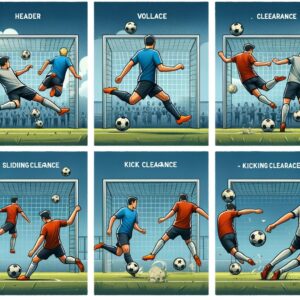In the dynamic and fast-paced world of soccer, every action taken on the field has a pivotal role in shaping the game’s outcome. One such aspect that often turns the tides is the defensive maneuver known as a clearance. This technique is not just a random kick away from the goal; it is a crucial and strategic move, performed with precision to alleviate pressure from the defense.
As a former soccer player, I’ve personally experienced the adrenaline rush and the quick decision-making needed to execute a successful clearance.
A clearance in soccer is more than just booting the ball away. It’s a skillful blend of timing, anticipation, and tactical awareness. To explore this further, let’s consider its significance in the game. When a team is under siege, a well-executed clearance can not only prevent a goal but also shift the momentum of the game. It’s a moment where the plays of the game pivot, transitioning from defense to offense.
The ability to perform a clearance effectively can often be the difference between a narrow escape and a disastrous goal conceded. So, lets get to know what exactly it is, how it is performed and what importance it holds in the game.
What is a Clearance in Soccer?
In the world of soccer, a clearance is a fundamental defensive action. Imagine this: the defending team is under pressure, the opposing team is advancing like a storm, and the goal is under an impending threat. In such moments, clearance becomes the beacon of hope. It is the act where a player purposefully removes the ball from the team’s defensive area.
This move is not just about ejecting the ball; it’s about strategically averting a potential score by the rivals. When I played as a defender, the rush of executing a timely clearance was unmatched, knowing it could drastically reduce the risk of conceding a goal.
The Art of Timely Response
Typically, a clearance occurs when the defending team is cornered or under pressure. It’s a critical decision made in split seconds. The goal is to quickly regain control of the situation. Whether it’s a powerful kick or a calculated pass, the essence lies in its immediate execution.
In my playing days, the emphasis was always on how swiftly and efficiently we could transition from defense to offense. A well-timed clearance not only disrupts the opponent’s momentum but also paves the way for a counter-attack.
Reducing Risks, Gaining Control
The beauty of a clearance lies in its dual ability to reduce risk and simultaneously set the stage for regaining possession. It’s not just about repelling an impending threat; it’s about resetting the game’s dynamics.
For players, mastering the art of clearance is about understanding the balance between urgency and precision. It’s a skill that often goes unnoticed but plays a pivotal role in the game’s outcome. As a former player, the sense of relief and strategic satisfaction in executing a perfect clearance was always a highlight of the match.
Types of Clearances

In soccer, the art of defending involves various types of clearances. These clearances are essential tools in a player’s arsenal, used depending on the situation and their individual strengths. As a coach and former player, I have seen how these techniques can change the course of a game.
- Header Clearance
Header clearance is a classic move where a player jumps and uses their head to clear the ball away from danger. However, for players under 12, many leagues do not allow headers to protect young athletes. This rule shapes how youth teams approach defensive strategies.
- Volley Clearance
Volley clearance is another dynamic technique. Here, a player kicks the ball out of the air before it hits the ground, sending it far down the field. It requires exceptional timing and skill, making it a spectacle when executed perfectly.
- Slide Tackle Clearance
Slide tackle clearance involves a player sliding on the ground and using their feet to clear the ball. While effective, it is a risky play that can result in a penalty or injury if not done correctly. It’s a move that requires precision and careful judgment.
- Boot Clearance
Boot clearance is probably the most common type of clearance among youth soccer teams. A player simply kicks the ball as hard as they can to get it out of their half of the field. It’s a straightforward yet effective method to quickly move the ball away from the goal area.
Each type of clearance demands different skills and understanding. The choice of clearance often reflects the team’s strategy and the players’ abilities. As a coach, teaching young players the right moment to use each clearance type is key to developing their defensive skills.
When to Use a Clearance in Soccer
Clearances are a vital part of a soccer team’s defensive strategy. They are typically used when a team is under pressure from the opposing team. The main objective is to rid the ball as quickly as possible from danger zones. In my years of coaching, I’ve emphasized that clearances are not just desperate attempts to throw the ball away; they are calculated moves to regain control.
The Right Moment for Defensive Action
In many cases, defenders have the time to collect themselves and make a decision. The choice to either pass to a teammate or blindly kick the ball out of their area is crucial. It’s about understanding the common situations where a clearance is necessary. For instance, when the opposing team is pressing high on the field, increasing the pressure on the defensive team, a well-timed clearance can change the game’s flow.
Goalkeeper’s Role in Clearances
The goalkeeper, holding the possession of the ball in their half of the field, also plays a key role in clearances. They must decide whether to distribute the ball to defenders or clear it far downfield. This decision often comes into play during intense moments, like when a defender is closed down by an opposing player and needs to avoid losing possession.
Clearances During Set Pieces
Another critical scenario is during a corner kick, when everyone is jumbled together in the box. Here, a clearance can relieve the pressure and help the team regain possession. It’s a moment where every player’s awareness and quick response can significantly impact the game’s outcome.
Why Is a Clearance Important in Soccer?
In the strategic world of soccer, clearances play a crucial role. They are not just random kicks but calculated actions that help teams regain control of the game and prevent goals. As a former soccer coach, I’ve always taught my players the significance of clearances in maintaining the flow and balance of the game.
The Core of Defensive Strategy
Clearances are an integral part of a team’s defensive strategy. When a team is under pressure, a well-timed clearance allows defenders to relieve immediate danger and reorganize their defensive shape. This swift action can be the difference between conceding a goal and resetting the play.
Counter-Attacking Opportunities
One of the most exciting aspects of clearances is the Counter-Attacking Opportunities they present. A successful clearance can quickly transition a team from a defensive to an offensive position. Clearing the ball away from danger and having it picked up by an attacker can initiate a counter-attack against the opposing team.
Preventing Goals
In soccer, Preventing Goals is as important as scoring them. Clearances are often performed near the goal line or in dangerous areas of the field, where a single mistake can lead to a goal. By clearing the ball, defenders significantly diminish the risk of conceding and help maintain a clean sheet.
Buying Time for Tactical Readjustment
Clearances can also buy valuable time for a team. They allow players to regroup, catch their breath, and reestablish their defensive structure. This breather can help players mentally refocus and analyze the game’s dynamics, adjusting their strategy accordingly.
Common Clearance Mistakes and How to Avoid Them
Clearances in soccer are crucial, but even seasoned players can make mistakes. Understanding these errors and knowing how to avoid them can greatly improve your team’s performance. Here are some tips to avoid common mistakes in clearances.
Mistake #1: Excessive Force in Clearances
Mistake #1 is Kicking the ball too hard. It might seem like a good idea to get the ball far away from the goal, but this approach is often counterproductive. A kick that’s too hard makes it difficult for teammates to control the ball, and it may end up out of bounds or back to the opposing team. This can start another attack while your team is scattering to get into their positions.
To avoid this mistake, focus on accuracy rather than power when you make your clearance. Aim for a specific spot on the field where your teammates can easily control the ball and start a counterattack.
H3: Mistake #2: Misdirected Clearances
Mistake #2 involves Clearing the ball straight up in the air. Kicking the ball straight up the middle of the field may seem like a safe option, but it’s actually quite dangerous. When you clear the ball in the middle, it gives the opposing team time to regroup and potentially create another scoring opportunity.
Try to clear the ball to the side of the field. This makes it more difficult for the opposing team to control the ball and start their offense. Use the sidelines as an extra defender.
H3: Mistake #3: Indecisiveness in Clearances
Mistake #3 is being Not sure whether to pass or clear. When you’re undecided about clearing it or passing it, the split-second hesitancy can lead to mistakes. For example, a cross might come into you and you initially want to clear it but then you see an open teammate. You try to pass to that teammate, but muscle memory kicks in and it floats over their head.
This can lead to another attack by the offensive team. A quick lapse in judgment can cost teams a victory. A defensive player may overthink their clearance and take one more touch, but the offense gets there to steal it. This often leads to a great opportunity to score by the opponent.
Conclusion
Mastering the art of clearances in soccer is a combination of skill, strategic understanding, and quick decision-making. Whether it’s avoiding common mistakes like excessive force or misdirected kicks, or understanding when to clear versus pass, each element plays a vital role in the game’s defensive dynamics.
Clearances, while often overlooked, are essential maneuvers that can change the course of a match, offering both defensive security and opportunities for counterattacks. As players and coaches alike focus on refining these techniques, they contribute significantly to the team’s overall performance and success on the field.
Frequently Asked Questions
What is a clearance in soccer?
A clearance in soccer is a defensive technique used by players to remove the ball from their team’s defensive area, particularly when under pressure from the opposing team. It involves quickly and strategically moving the ball to a safer area on the field to prevent scoring opportunities.
What is clearing in soccer?
Clearing in soccer refers to the action of forcefully removing the ball from near the team’s goal or defensive area. This is done to mitigate immediate threats and disrupt the opposing team’s offensive play, often leading to a shift from defense to offense.
Do goalkeepers get clearances?
Yes, goalkeepers can execute clearances in soccer. They often clear the ball during high-pressure situations, especially when receiving back passes or after saving shots, to quickly move the ball away from the goal area.
What is a defense clearance in football?
A defense clearance in football (soccer) is a quick action taken by a defender to remove the ball from the vicinity of their goal line or defensive third to reduce the risk of the opposing team scoring. It’s a critical component of a team’s overall defensive strategy.
What is a sports clearance?
In the context of soccer, a sports clearance refers to the act of a player (usually a defender or goalkeeper) removing the ball from their defensive zone to lessen the pressure from the opposing team and to safeguard their goal.
What are the three types of clearance?
The three common types of clearances in soccer are:
- Boot Clearance: Involves kicking the ball as far as possible, usually used by youth teams.
- Header Clearance: Utilizes the player’s head to clear the ball, especially during aerial threats.
- Slide Tackle Clearance: A defensive move where a player slides on the ground to clear the ball, which can be risky but effective.

